This lesson shows you how to create a pair of twisting horns. It uses extrusions and transforms; it also demonstrates spline extrusion as a simple alternative to multiple extrusions.
Once again, apply a Symmetry modifier to mirror the edits you make to one half of the helmet.
 open helmet_03.max.
open helmet_03.max.
 select the helmet, and make
sure the
select the helmet, and make
sure the  Modify panel is active.
Click
Modify panel is active.
Click  (Use NURMS) to turn it off.
(Use NURMS) to turn it off.
Split the model in half and apply a Symmetry modifier:
 Polygon Modeling panel, activate
Polygon Modeling panel, activate  (Polygon).
(Polygon).  Select the polygons on the
left half of the helmet (from your point of view), and then press Delete.
Select the polygons on the
left half of the helmet (from your point of view), and then press Delete.
On the Modify panel,
you can toggle  (Show End Result) to make
sure the helmet is mirrored correctly.
(Show End Result) to make
sure the helmet is mirrored correctly.
 Polygon Modeling panel, click
Polygon Modeling panel, click  (Previous Modifier) to go
to the Editable Poly level.
(Previous Modifier) to go
to the Editable Poly level.
Adjust vertices at the base of the horn:
 Polygon Modeling panel, activate
Polygon Modeling panel, activate  (Vertex).
(Vertex).
 Edit panel
Edit panel  Constraints group, activate
Constraints group, activate  (Constrain To Edge).
(Constrain To Edge).
This ensures that the transform of any vertex will slide along the edges of the polygon to which it belongs.
 (Zoom Extents) to get a
good view of the helmet.
(Zoom Extents) to get a
good view of the helmet.
 (Select And Move), then
select a vertex in the upper region of the helmet and move it as shown
in the next illustration.
(Select And Move), then
select a vertex in the upper region of the helmet and move it as shown
in the next illustration.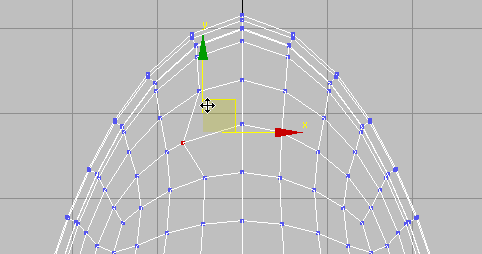
 move it as well. Also move
the vertices above and below the central vertex. The goal is to
create a symmetrical shape that is roughly circular.
move it as well. Also move
the vertices above and below the central vertex. The goal is to
create a symmetrical shape that is roughly circular.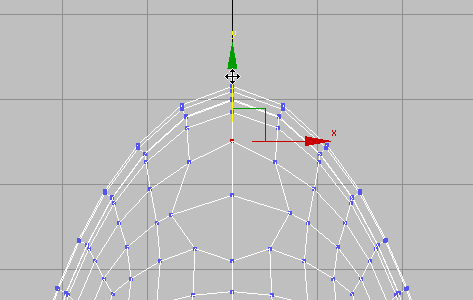
 Edit panel, activate
Edit panel, activate  (Constrain To None).
(Constrain To None).
 Select the vertex at the
center of the circular group of polygons.
Select the vertex at the
center of the circular group of polygons.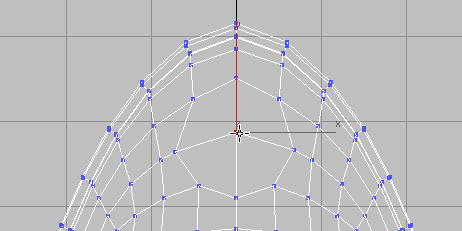
 Polygon Modeling panel, Ctrl+click
Polygon Modeling panel, Ctrl+click  (Polygon).
(Polygon).
This automatically selects all the polygons that share the vertex.
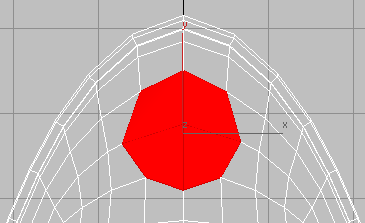
 Orbit so you can see all
of the base of the horn.
Orbit so you can see all
of the base of the horn.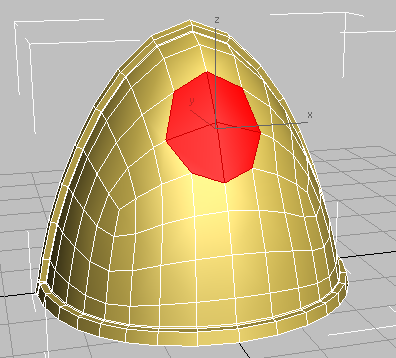
 (Inset).
(Inset).
 (OK).
(OK).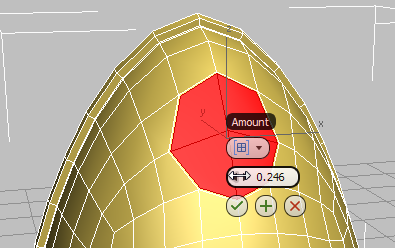
This creates an inset edge for the selected polygons.
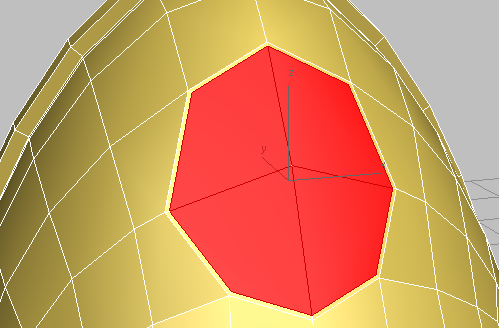
Use extrusion and bevel to create the socket for the horn:
 (Extrude).
(Extrude).
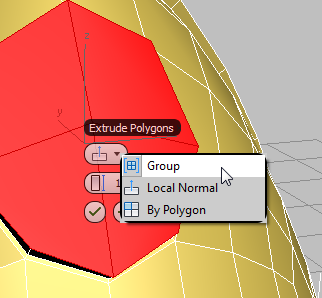
 (OK).
(OK).
 (Bevel).
(Bevel).
 (OK).
(OK).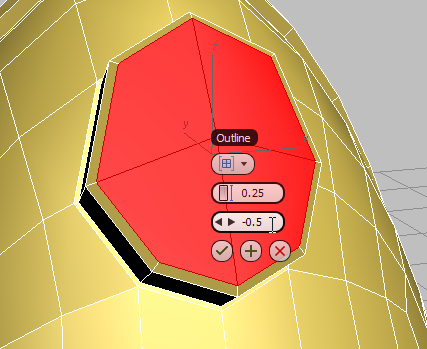
Helmet horn socket after first extrusion and bevel
 (Inset).
(Inset).
 (OK).
(OK).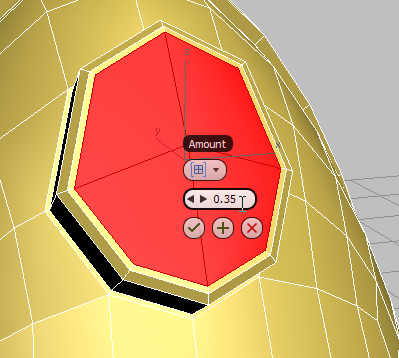
 (Bevel).
(Bevel).
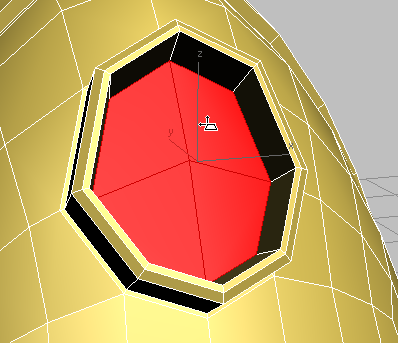
Horn socket after second inset and bevel
 (Extrude) again, and drag
away from the helmet until the polygons extend slightly beyond the
socket. Click to end the extrude operation.
(Extrude) again, and drag
away from the helmet until the polygons extend slightly beyond the
socket. Click to end the extrude operation.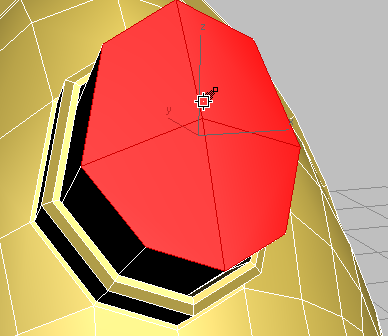
Helmet horn ready for spline-based extrusion
At this point, you could continue to create the horn by using the Move, Rotate, and Scale tools, coupled with the Extrude, Bevel, and Inset polygon tools. Instead, you will guide the extrusion by means of a path.
Draw a spline for extruding the horn:
 Create panel, click
Create panel, click  (Shapes), then on the Object
Type rollout, click Line.
(Shapes), then on the Object
Type rollout, click Line.
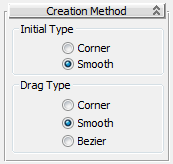
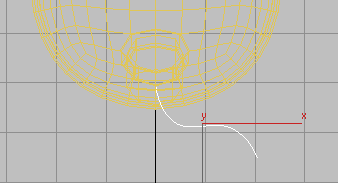
 move the line along its
Y axis until it is centered on the horn socket. Move it along the
X axis too, if you need to.
move the line along its
Y axis until it is centered on the horn socket. Move it along the
X axis too, if you need to.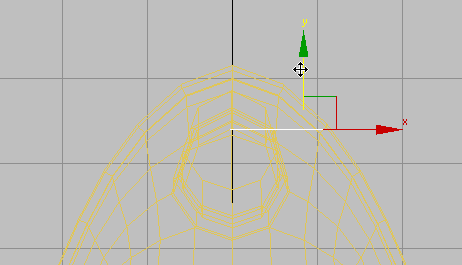
 Modify panel
Modify panel  Selection rollout, and
activate
Selection rollout, and
activate  (Vertex).
(Vertex).
 Maximize the Perspective
view and
Maximize the Perspective
view and  move the line’s vertices
until they form the shape of the horn you want to create.
move the line’s vertices
until they form the shape of the horn you want to create.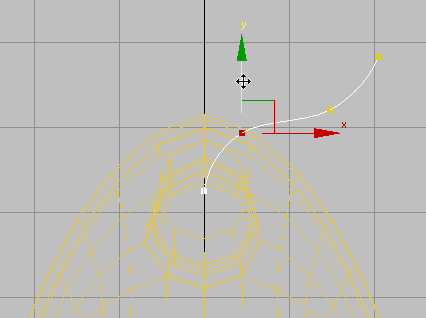
 Double-check and refine
your Line edits in the other viewports.
Double-check and refine
your Line edits in the other viewports.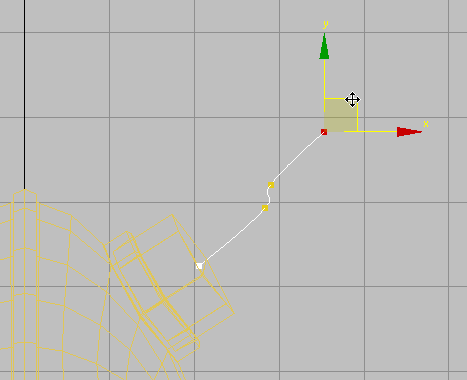
Left view
 (Vertex) once more to turn
it off.
(Vertex) once more to turn
it off.
 Select the helmet, then
on the ribbon
Select the helmet, then
on the ribbon  Polygon
Modeling panel, click
Polygon
Modeling panel, click  (Previous Modifier) to go
to the Editable Poly level.
(Previous Modifier) to go
to the Editable Poly level.
 (Polygon), then click
(Polygon), then click  (Show End Result) to turn
it on.
(Show End Result) to turn
it on.
 drop-down panel, Shift+click
Extrude On Spline.
drop-down panel, Shift+click
Extrude On Spline.
The caddy controls for spline extrusion are more numerous than for most caddies.


After you click the spline, 3ds Max grows horns, but these have no taper, yet.

3ds Max aligns the spline to the normals of the original faces, making the horns more perpendicular to the rest of the helmet. This might or might not be a good effect, depending on the spline you drew.
 (Apply And Continue).
(Apply And Continue).
3ds Max extrudes the horns still further. This is easier to see in other viewports, but you can also navigate the Perspective view, as shown in this illustration.

 (OK) to finalize these changes
and finish creating the horns.
(OK) to finalize these changes
and finish creating the horns.
By extruding the horns along a path, you saved yourself a great deal of back-and-forth between the transform and polygon modeling tools.
 Polygon Modeling panel, click
Polygon Modeling panel, click  (Polygon) again to turn
it off.
(Polygon) again to turn
it off.
Make the helmet a single object once again:
 (Use NURMS) is off. NURMS
smoothing needs to be off before you transform the helmet into an
Editable Poly: Otherwise, you wind up with a model that has far
too many faces.
(Use NURMS) is off. NURMS
smoothing needs to be off before you transform the helmet into an
Editable Poly: Otherwise, you wind up with a model that has far
too many faces.
 Convert To Editable
Poly, then press F4 to turn off edged
faces.
Convert To Editable
Poly, then press F4 to turn off edged
faces.
The Symmetry modifier is removed and all the mirrored polygons are integrated into the model.